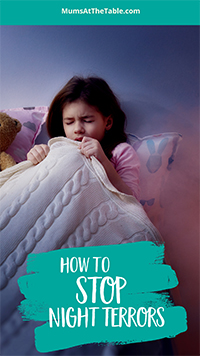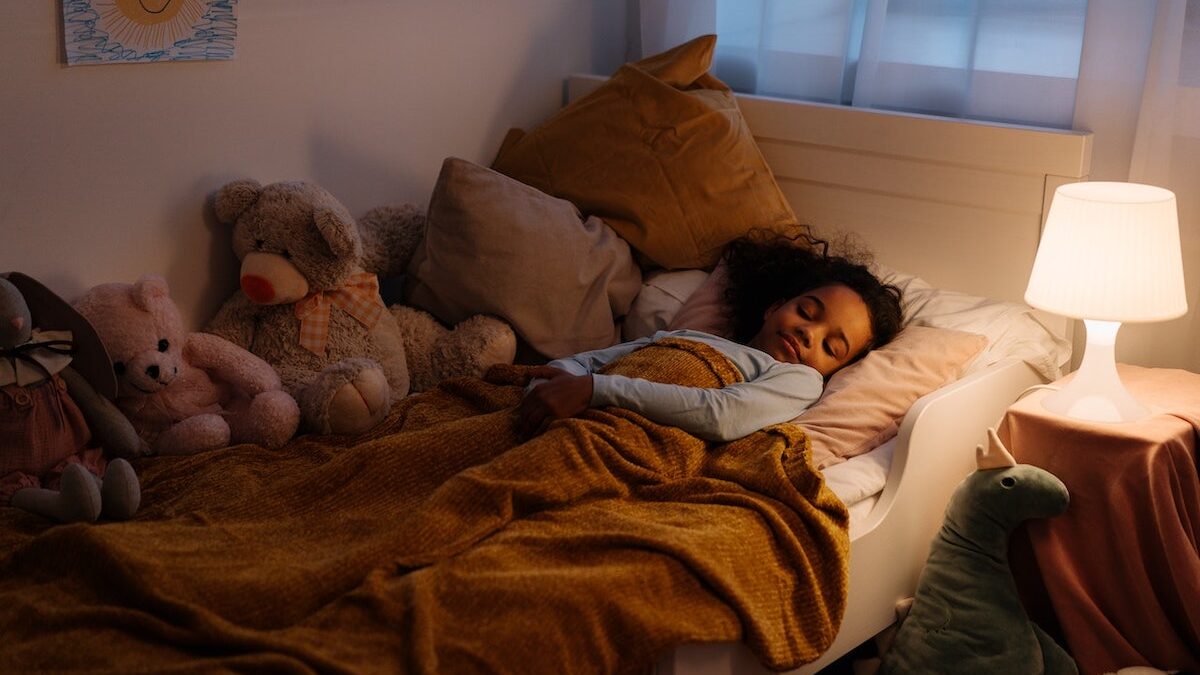Night terrors are very different to your child having a nightmare. How does it happen and how can you help your child? We have the answers.
Most parents have comforted their child after a nightmare by hugging them and settling them back to sleep. Night terrors are something altogether different, where a child is often inconsolable, full of fear, and temporarily unable to come out of the nightmare and back into reality.
Night terrors, or sleep terrors, are a type of sleep interference similar to nightmares or scary dreams, only much more dramatic with intense fear and panic.
Witnessing your child having night terrors can be both scary and concerning, especially when you’re unable to rouse or comfort your child. Read on as we provide advice on what to do when your child is experiencing sleep terrors, and how you can prevent future episodes from occurring.
What is the difference between a nightmare and a night terror?
When you have a nightmare, you are often able to wake up from it and can remember some of the details. Someone having a night terror often remains asleep and usually doesn’t remember anything of the episode in the morning.
The signs and symptoms of a night terror include:
- a sudden scream—the child may look very scared
- the child’s eyes may be open with a glassy stare
- thrashing of the arms and legs wildly, or getting up and running around
- the child is “stuck” in the nightmare, unable to be roused or stopped
- breathing and heartbeat are fast
- the child may be very sweaty
- the child is unable to recognise anyone and cannot be comforted
- the night terror lasts 10 minutes or more
- no recall of the night terror upon waking
What is the main cause of night terrors?
Night terrors are thought to be caused by over-arousal of the central nervous system during sleep. They are classified as a sleep disorder or parasomnia—an undesirable behaviour or experience during sleep.
Sleep happens in several stages and repeats every 90 minutes in what is called a sleep cycle. Each stage has varying physical effects and benefits on the body. During the stage called Rapid Eye Movement (REM) sleep, a person may be woken up easily. Dreams or nightmares may frequently occur as this is the lightest stage of sleep.
Night terrors occur when a person moves into the deepest stage of sleep called slow-wave sleep or non-rapid eye movement (non-REM) sleep. A night terror is not necessarily a dream, but more like a sudden and acute reaction that happens during the transition from one sleep stage to another, and involves fear and panic.
Various factors can contribute to sleep terrors, such as:
- sleep deprivation
- sleep schedule disruptions (such as travel or sleep interruptions, new sleep environment)
- extreme tiredness
- stress, anxiety or emotional disturbances
- being ill or having a fever
- medications
- restless leg syndrome
- obstructive sleep apnoea
- caffeine consumption
What to do when your child has a sleep terror
Sleep terrors affect almost 40 per cent of younger children up to 12 years old. However frightening, sleep terrors aren’t usually a cause for concern. Most children will outgrow sleep terrors by the time they become teenagers.
When a child has a sleep terror, the episode can be very disturbing and uncomfortable for parents to witness. Parents and caregivers may want to try and wake up the child so they can get out of a bad dream. However, you should resist the urge and instead follow these five simple steps.
- Stay calm and don’t touch your child unless they are going to hurt themselves or others. They are in a deep sleep and are unable to hear or respond to you.
- Make sure the house is safe at night. Lock windows and doors, and clear the bedroom floor of objects so they don’t step on or trip over things.
- Speak in a calm and soothing voice, encouraging your child that everything is going to be OK.
- Wait it out patiently with your child until the sleep terror is over.
- Keep a sleep diary to take notes on their sleep terror episodes.
A child’s night terrors can make them feel embarrassed, because they have no control over themselves and may do or say things that don’t make sense. Close family members must be aware of the night terrors to know how to properly respond.
Never make fun of or condemn children for having a night terror, as this will only add to their stress, possibly causing more sleep disturbances.
Doctor’s advice: How to reduce night terrors
Dr Ann Halbower, director of the Pediatric Sleep Medicine Program at Children’s Hospital Colorado, told Fox 4 news, “Kids who are up and paying attention to an electronic device are sleeping less. Sleep deprivation can make [night terrors] worse because kids when they’re overtired tend to have more of these confusional arousals.”
Taking into consideration the factors that can contribute to night terrors, parents must establish some healthy boundaries to ensure their family gets adequate and good quality sleep.
Some things to practice to help with reducing or preventing night terrors include:
- establish a consistent and calming bedtime routine
- make sure your child is not staying up late
- put your child to bed in a cool, dark and quiet bedroom
- no screen time after dinner
- if your child experiences night terrors around the same time each night, you can wake them up 30 minutes prior to help them break the sleep cycle
Parent’s advice on night terrors
We collected some suggestions from mums from our Mums At The Table Facebook group with children who have experienced night terrors. Here’s what they had to say:
- Alexandra: Both my kids have had sleep terrors. They say best to not wake them. Just lots of comfort. Otherwise rescue remedy before bed, lavender in the humidifier. It’s very distressing to watch!
- Lidia: No screen time for a week. No sugar. Lots of healthy foods. Calm music while playing and some quality outdoor time. The most important time to keep calm is the hours before bedtime.
- Jourdane: My girl had night terrors twice through the night, always an hour into her sleep and 3 am, and lasted a few months. She’s just over 2yo now and finally they have stopped. I kept to the same routine throughout the day. They were worst when she went to bed overtired.
- Shaqueena: My second child had night terrors. What made it even more scary was that he’d be sitting up, eyes open, just screaming. I just used to hold him and gently ease him back into a prone position. He never remembered anything. I still remember 15yrs later.
- Anastasia: From what I’ve read, they’re not awake or aware, and the best thing to do is leave them be, stay close and make sure they’re safe. They’re more likely to freak out if you wake them.
When to see a doctor
If your child has severe night terrors characterised by any of the following, you should have your child seen by a doctor. Your GP may refer your child to a paediatrician or sleep specialist for further investigation or a sleep study.
Night terrors need to be medically assessed if the following occurs:
- violence or there is a high risk of injury to your child, yourself or others
- your child has frequent night terrors that are disrupting the family’s sleep
- your child has drooling, stiffening and/or jerking of the body
- the night terror episode lasts longer than 30 minutes
- the episode happens in the second half of the night
- your child has daytime fears
Remember that sleep terrors are usually harmless and many children eventually grow out of them.
Note: Any advice given is general in nature and is not intended as a substitute for medical advice and must not be relied upon as such. For any healthcare advice, always consult a healthcare practitioner.

How helpful was this article?
Click on a star to rate it!
5 / 5. 1
Be the first to rate this post!
Adriana Wales
Related posts
Subscribe
Receive personalised articles from experts and wellness inspiration weekly!


